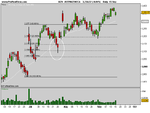barjon
Legendary member
- Messages
- 10,752
- Likes
- 1,863
..........I'll tell you what though - let's expand the offer I made earlier. If someone can give a combination of TA indicators, I will code it up and data mine across multiple markets to show how well they work (or not) in unison.............
ok, toastie 🙂
1. daily time frame - candles drawn on mid-price - rules for longs (shorts vice versa)
2. 3+ candle retracement in established uptrend not exceeding 50% of last move on the close (ie: from last swing low)
3. Third or subsequent candle in retracement a hammer (shooting star for shorts)
4. enter long when offer exceeds high of hammer - stoploss when bid takes out low of hammer.
Better not confuse matters with how to manage things from there - just be content with direction?
Here's the latest example I've got so you get the picture. It's not a very good one since the gaps made it difficult to trade. Direction was good though 🙂
jon

